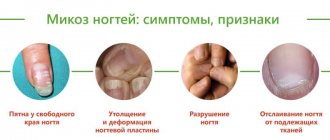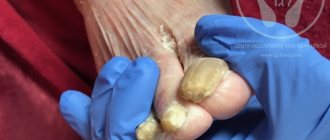HPV itself does not affect a woman’s ability to become pregnant, carry and give birth to a healthy child. But in the human body everything is interconnected, and one problem in most cases can lead to a number of others - the “domino principle” works. Therefore, in the case of a diagnosed human papillomavirus, it is recommended to regularly undergo immunological, gynecological and oncological examinations and treatment.
According to statistics, up to 30 percent of Russian women of reproductive age are exposed to the human papillomavirus (HPV). Therefore, it is important for every expectant mother to know how this virus can affect the ability to have children.
Victoria Viktorovna Zaletova, chief physician of the MAMA clinic:
And what danger can neoplasms on the breast pose?
The female body is an amazing biological system, which during pregnancy faces enormous stress and not only successfully overcomes all challenges, but also transforms and transforms, adapting to any needs of the baby. It’s great when the period of bearing a child passes easily, without such unpleasant surprises as papillomas during pregnancy.
But if epidermal tumors do appear, the expectant mother faces an acute question regarding the removal of the growth and its effect on the development of the baby. Indeed, is it possible for pregnant women to remove papillomas and why, while expecting a baby, do warts choose the breasts of the expectant mother?
Human papillomavirus infection (HPV) - symptoms and treatment
In 90% of cases, a healthy human immune system copes with human papillomavirus infection on its own within a period of six months to two years from the moment of infection, after which a complete recovery occurs with the disappearance of the virus from the body. In this case, intense lifelong immunity is not formed, that is, a person can become infected again.
In other cases, in the presence of predisposing factors, the disease takes on a chronic form, prone to a long latent course with periodic relapses and the possible development of severe complications.
From the moment the virus enters the body to the development of precancerous conditions and, especially, the appearance of cancer, quite a long time can pass, sometimes tens of years. Therefore, regular preventive examinations, timely detection and treatment of precancerous conditions are a very real and effective way to avoid the worst case scenario.[13] To this end, the World Health Organization recommends that all women over 30 years of age undergo not only a “routine” cytological examination during initial screening, but also a test for the presence of HPV.[10]
Regular visits to the gynecologist (if there are no complaints - once a year) with a Pap test allows you to timely detect the initial signs of dysplasia and take all necessary measures to prevent the progression of the process and its transition to cancer.
The use of barrier contraception methods, although not completely protects against infection, somewhat reduces its likelihood.
The main method of primary prevention of human papillomavirus infection is vaccination . [11] Modern vaccines are developed to protect against the most dangerous, highly oncogenic strains of HPV, responsible for 70-80% of cases of cervical cancer. A standard course of three vaccinations provides quite reliable protection.
It is advisable to vaccinate children (girls, and boys to curb the spread of infection) from 9-10 to 17 years old, as well as young women (18-25 years old) before engaging in sexual activity, since the vaccine prevents infection, but is not a means of treatment. developed infection. If the patient is already sexually active, then before vaccination she needs to undergo testing for the presence of human papillomavirus infection. However, even if one of the strains included in the vaccine is identified, vaccination can still be carried out, since this is not a contraindication.
Papillomas in pregnant women: features of formation and localization
Before moving on to the main topic, it is necessary to recall that papillomas are benign neoplasms that are formed as a result of atypical proliferation of epidermal tissue. The cause of such skin defects is the human papillomavirus (HPV), which is present in a latent state in the body of almost all people on the planet. The vital activity of the virus can be activated by factors that weaken the body, such as decreased immunity, fatigue, severe infectious or inflammatory processes, poor nutrition, etc.
Hormonal changes can become an ideal background for the activation of HPV and the formation of papillomas, which is what happens in the body of pregnant women. If we add to all of the above the enormous load on the body of a woman who is in an “interesting situation,” the etiological picture becomes obvious.
Doctors noted that the localization of papillomas during pregnancy changes somewhat. The priority area of damage is the breast of the expectant mother. Moreover, neoplasms can appear on any part of the mammary gland, from the nipple to the internal ducts. This does not mean that the possibility of papillomas appearing on the neck, face, arms and legs during pregnancy is excluded, however, the incidence of such defects is significantly reduced.
There are several types of location of breast tumors:
- Papilloma on the chest - forms on the epidermis of the mammary gland and is a small oval or spherical growth on a narrow base, which has a soft consistency. Such a neoplasm is most often not accompanied by pain, but when wearing tight underwear it can become injured, inflamed and bleed.
- Papillomas under the mammary glands - usually form in the form of multiple small papules, which are located directly under the breast. They are also prone to injury and spread to healthy areas of the skin.
- Papilloma on the nipple - forms in the form of a soft, light structure with a rough surface, and can be localized both directly on the nipple and on its halo (pigmented part of the breast). This type of neoplasm not only makes wearing underwear difficult, but also significantly complicates subsequent breastfeeding.
- Intraductal papilloma of the mammary gland - forms in the internal duct of the breast, which makes it difficult to detect. You can detect such an internal growth yourself by palpating the breast. Often intraductal papilloma is accompanied by specific discharge from the nipple, as well as burning and intense pain. Only a professional mammologist can make a final diagnosis based on ultrasound of the breast.
Can pregnant women have warts removed with laser?
The question of whether it is possible to remove warts during pregnancy using a laser is the second most popular question. However, there is no clear answer to this either. Laser therapy is considered a more effective and reliable method of getting rid of most skin lesions. Significant advantages of this procedure are accelerated recovery after surgery, compared to cryodestruction, as well as a low likelihood of relapses and scar formation at the site of wart removal. The downside is that it takes a long time for the tissue to heal after the plantar growths are removed.
Are breast papillomas dangerous during pregnancy?
Regardless of location, papillomas during pregnancy can cause significant discomfort to a woman and cause concern for the health of the child. It should be understood that the papillomavirus cannot influence the development of the baby in any way, however, with a high degree of probability, the child will be a carrier of the viral agent at birth, which will enter the body through the perinatal route of infection. This most often manifests itself in the formation of epidermal neoplasms in childhood.
As for the risks to a woman’s health, there are several potential dangers, the most significant of which can be considered the possibility of malignant transformation of a harmless neoplasm, which leads to an oncological process. This is especially true for intraductal papillomas, which can exist for a long time in a latent, undiagnosed form. In addition, such papillomas after childbirth during the process of active growth can clog the duct, preventing the outflow of breast milk, which can cause stagnation.
There is also a risk of mechanical damage to the tumor when wearing too tight underwear and clothes. This outcome may be accompanied by severe bleeding and infection of the wound, which is unacceptable during pregnancy.
Is it possible to remove warts during pregnancy on your own?
Many people are interested in whether it is possible to remove warts for pregnant women at home? Indeed, some folk remedies have proven themselves very well in solving this problem. But how they will affect the baby’s health is not known for certain. Therefore, in any case, it is impossible to do without prior consultation with a doctor. And if there are neoplasms in the intimate area, self-medication is strictly prohibited!
Papillomas during pregnancy: treatment
It is advisable to remove any neoplasms located on the skin and mucous membranes before pregnancy. If for any reason this rule was not followed, or primary papillomas appeared during pregnancy, the woman should immediately contact a specialist. Depending on the location of the defect, medical advice and assistance can be provided by a dermatologist, mammologist, gynecologist or oncologist.
It is strictly forbidden to resort to self-medication with the help of pharmaceutical ointments and plasters, folk recipes, as well as mechanical cutting of the body of the wart during pregnancy.
Is it possible to remove warts with nitrogen during pregnancy?
Can pregnant women remove warts with nitrogen in a clinical setting? There are no strict contraindications in this regard, however, some nuances of such procedures should be taken into account. On the one hand, cryodestruction is the cheapest and, most importantly, painless method of removing ill-fated formations. However, not all skin growths can be gotten rid of with its help. Thus, plantar warts are destroyed most effectively when treated with liquid nitrogen. However, it is impossible to influence the mucous membranes of organs (in particular, the uterus) in this way.
In addition, the cryodestruction method involves several procedures. And given that anesthesia is contraindicated at any stage of pregnancy, this only creates additional stress for the expectant mother’s body.
How else can you remove warts in pregnant women?
Methods that have proven themselves in removing skin lesions in pregnant women also include radio wave therapy and electrocoagulation .
The first is a targeted effect on the wart with a so-called radio knife. As a result, it is destroyed while maintaining the integrity of healthy tissue. The likelihood of relapse is negligible. A significant disadvantage is the risk of scar formation after removal of a large tumor. Therefore, the radio wave method is usually used to get rid of papillomas, which have a characteristic thread-like base.
The second one works on a similar principle. The only difference is that the excision of the wart is carried out with an electric scalpel, which literally evaporates it to the very root. In this case, the microvessels are welded together without causing bleeding. Electrocoagulation not only removes the wart, but also reduces to zero the likelihood of its reappearance or further growth. And when getting rid of benign tumors, it does not allow them to turn into a malignant form.
Diagnosis of HPV
Diagnosis and treatment of HPV in women is carried out by a gynecologist; men can consult a urologist and dermatovenerologist. To diagnose papillomavirus in the human body, Pap tests and HPV tests are used.
One of the ways to diagnose HPV in women is colposcopy, which allows you to visually assess the condition of the cervix and vagina.
If the presence of intraurethral formations is suspected, an endoscopic examination of the urethra may be indicated, and a biopsy for oncological diagnostic purposes.
Safe removal of warts and papillomas at the Stoletnik MC
We have sorted out the question of whether it is possible to remove warts during pregnancy. If you are looking for where you can do this in Penza, we invite you to the medical office at the address: st. Chaadaeva, 95.
Highly qualified specialists and modern equipment are at your service. The procedure for excision of warts is performed surgically or by electrocoagulation. The extensive experience of our doctors and an individual approach to each patient guarantee a positive result when removing tumors of any complexity, without risks to the health of the mother and baby.
Make an appointment and consultation by phone: +7 (8412) 999-395, 76-44-20.
Literature
- Adler J. What the skin hides. 2 square meters that dictate how we live. – M.: Bombora, 2022. – 352 p.
- Gomberg M. A., Soloviev A. M. Treatment of warts and genital warts is simple and effective // Medical Council. − 2011.− No. 5. − P. 60−65.
- Molochkov A.V., Khlebnikova A.N., Lavrov D.V., Gureeva M.A. Genital papillomavirus infection. Tutorial. − 2010. − 10 p.
- Rogovskaya S.I. Human papillomavirus infection in women and cervical pathology. − M.: GEOTAR-Media, 2005. − P. 15–17.
- Yunusova E. I., Yusupova L. A., Mavlyutova G. I., Garayeva Z. Sh. Flat warts: features and treatment options // Attending physician (electronic edition). − 2016.− No. 5.











